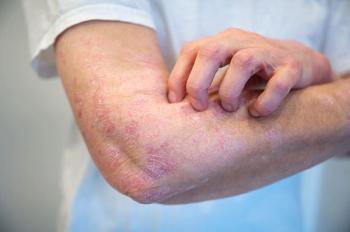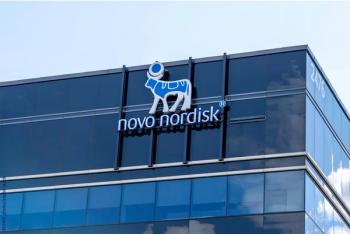
Ecchymoses From Cupping and Cullen Sign
Four cases to test your diagnostic skills: bizarre circular ecchymoses, abdominal ecchymosis, myriad nodules, and cavernous dilated blood vessel in a patient’s arm.
Circular Ecchymoses
Distinct ecchymotic lesions are noted on the back of a 57-year-old Vietnamese woman who presents to the emergency department with progressive malaise, night sweats, fever, and a dry cough of 2 weeks' duration. For 2 months, she has been taking prednisone (20 mg/d), which was prescribed by another physician for suspected autoimmune hepatitis.
The patient's breath sounds are coarse; no wheezing, egophony, or dullness to percussion is noted. A chest film shows bilateral diffuse, patchy interstitial infiltrates with small nodules. Pulmonary tuberculosis is suspected, and the patient is placed in isolation. Treatment for Pneumocystis carinii infection and community-acquired pneumonia is started. A few days later, sputum smears are positive for acid-fast bacilli.
What do you suspect is responsible for the circular skin lesions?
Circular ecchymoses: These skin lesions are ecchymoses from cupping, a therapeutic maneuver in alternative medicine. This patient's husband had used a Vietnamese cupping set (inset) in an attempt to relieve his wife's upper respiratory tract symptoms.
Cupping involves the creation of a vacuum within a cup made of glass, iron, or bamboo that is applied to the skin for about 10 minutes. The suction can be created either mechanically via a hand pump (such as with a cupping set) or by means of fire and its oxygen-consuming effect. An alcohol-soaked cotton ball is ignited within the cup, which is then applied to the skin immediately after the fire dies. The use of fire provides not only suction but also heat therapy. A variation of the technique known as wet cupping involves puncturing the skin before application of the suction cups.
The suction causes superficial blood vessels in the dermis to break, which results in circular ecchymoses. These lesions may be confused with injuries of domestic abuse or symptoms of another disease process, such as lupus vulgaris, or steroid-induced dermatitis.
This patient responded to a 4-drug tuberculosis regimen of isoniazid, ethambutol, pyrazinamide, and rifampin. At discharge 4 weeks later, the ecchymoses had resolved.
(Case and photographs courtesy of Fawad Shaheen, MD.)
Abdominal Ecchymosis
Left-sided abdominal pain of 5 days' duration and the recent appearance of purplish discoloration on the abdomen prompt a 58-year-old woman to seek emergent medical care. She has also had a severe nonproductive cough for 2 months. The patient does not have diabetes, and she has not received the influenza or pneumococcal vaccines. She denies alcohol use. Other physical examination findings are unremarkable.
To what do you attribute the skin discoloration?
Abdominal ecchymosis: This is Cullen sign, a periumbilical ecchymosis classically associated with hemorrhagic pancreatitis (A). In this patient, the ecchymosis resulted from a rectus sheath hematoma caused by violent coughing. A CT scan revealed the hematoma on the left side (B). The platelet count and prothrombin time/partial thromboplastin time were normal.
Rectus sheath hematomas usually result from repeated bouts of severe coughing or vomiting and are caused by bleeding in the area of the inferior or superior epigastric arteries located behind the rectus abdominis musculature. Inciting factors include external trauma; surgery; excessive contractions of the rectus muscle from strenuous exercise; and repeated Valsalva maneuvers from severe coughing, vomiting, or straining. Hematomas below the arcuate line bleed more and may dissect extensively because there are fewer fascial structures to restrain the bleeding.
Patients with rectus sheath hematomas have acute abdominal pain, typically after an inciting event. A mass may be palpated and the Cullen sign may be noted after 2 to 5 days of symptoms. Diagnosis is usually based on ultrasonographic or CT findings.
Treatment consists of correction of any underlying bleeding disorder and alleviation of provoking symptoms, such as cough. Transfusion may be required in patients who are hemodynamically compromised (eg, those taking anticoagulants who have severe, potentially life-threatening bleeding). Surgical consultation is the standard of care. Occasionally, aggressive treatment, such as gel foam angiographic embolization, surgical evacuation, or vessel ligation, may be needed.
A narcotic cough suppressant was prescribed for this patient; she was also given an antibiotic because of the severity of the cough. Always consider pertussis in adults and children who have coughs that cause secondary complications, such as ruptured blood vessels, vomiting, or broken ribs. No definite cause of this patient's cough was identified, and she was subsequently lost to follow-up.
(Case and photographs courtesy of D. Brady Pregerson, MD.)
Myriad Nodules
Hundreds of tumors cover the skin of a 50-year-old woman with a history of learning disabilities, anemia, scoliosis, cholelithiasis, and hyperparathyroidism. The asymptomatic lesions, which began at birth as a single lesion and became innumerable by the age of 13 years, vary in size from a few centimeters to a few inches. The patient has twin daughters who have similar lesions and learning disabilities; no other family members are affected.
What is your clinical impression?
Myriad nodules: These lesions are characteristic of neurofibromatosis-an autosomal dominant disorder probably of neural crest origin that can involve any organ system. Neurofibromatosis type 1 (NF1, von Recklinghausen disease) represents 95% of neurofibromatosis cases. Its incidence is 1 in 3500 newborns. In contrast, the incidence of neurofibromatosis type 2 (bilateral acoustic neuromas/schwannomas) is 1 in 33,000 to 40,000 newborns.1
The hallmarks of NF1 are pigmentary lesions, such as café au lait spots, skin-fold freckling, and iris hamartomas (Lisch nodules); skeletal lesions, such as sphenoid wing dysplasia and pseudarthrosis; and tumors, such as optic pathway gliomas and neurofibromas. Patients may have a first-degree relative with the disorder. NF1 is diagnosed when 2 or more of the diagnostic criteria are present.2,3 In addition to these clinical features, 40% to 60% of children with NF1 exhibit specific learning disabilities, including attention deficit hyperactivity disorder and visuospatial processing deficits.2
The total number of neurofibromas seen in adults with NF1 varies from a few to hundreds or even thousands. Cutaneous and subcutaneous neurofibromas continue to develop throughout life, although the rate of appearance may vary greatly from year to year.
Several conditions may mimic NF1:
- Proteus syndrome is associated with thickening of palms and soles, hyperkeratosis, subcutaneous and abdominal lipomas, hamartomas, hemangiomas, and lymphangiomas.3,4 It has a similar pattern of inheritance and may present with multiple lesions (not neurofibromas) as well as café au lait spots.4
- McCune-Albright syndrome may manifest with precocious puberty, skeletal lesions, seizures, and skin discolorations, similar to NF1. However, the involvement of bone and skin is monolateral and does not cross the midline.4
- Multiple lentigines syndrome (LEOPARD syndrome), like NF1, is an autosomal dominant hereditary disorder. It is characterized by lentigines (which may be mistaken for café au lait spots), hypertelorism, prominent ears, and nerve deafness.4
- Tuberous sclerosis (Bourneville disease) also has an autosomal dominant pattern of transmission, although spontaneous mutation is possible. Skin discoloration, brain lesions, and seizure disorders are common with this disease; however, café au lait spots and fibromas are absent.4
(Case and photographs courtesy of Vasantha Kondamudi, MD, Pamella Charles-Pryce, MD, and Maritza De La Rosa, MD, of the Brooklyn Hospital Center, NY.)
Dilated Blood Vessel
A 45-year-old man complains that a dilated blood vessel in his left arm causes significant discomfort with motion; particularly irritating is the vibratory thrill from his elbow to the deltopectoral groove. He underwent a kidney-pancreas transplantation 7 years earlier.
What do you suspect, and how would you proceed?
Dilated blood vessel: This patient has a significantly enlarged arteriovenous fistula aneurysm that is at great risk for rupture (A). After his kidney-pancreas transplantation, he no longer required renal dialysis, but he neglected to undergo arteriovenous fistula reversal. The aneurysmal degeneration involved his entire upper arm and measured 5 cm at the antecubital fossa and 4 cm at the level of the deltopectoral groove. Operative repair entailed tedious dissection and resection with ligation of the entire arteriovenous fistula aneurysm and its branches. Photo B shows the patient's arm after the aneurysm was successfully repaired.
Aneurysms develop as a matter of course in arteriovenous fistulae. Their natural history is typically benign. Usually, they are revised before becoming so large, as a result of regular monitoring by the dialysis team. Surgical resection (with revision, if continued dialysis is necessary) is recommended when the aneurysm involves and compromises the arterial anastomosis, is characterized by rapid expansion, exceeds twice the diameter of the graft, or causes a steal syndrome.
(Case and photographs courtesy of John Zangmeister, MD.)
References:
Ecchymoses from Cupping
FOR MORE INFORMATION:
- Leung AKC, Robson WLM. Factitious dermatitis. Consultant. 2005;45:183-185.
- Schneiderman H. Coin-rubbing, folk remedies, and physical examination of immigrants. Consultant. 2006;46:557-561.
Cullen Sign
FOR MORE INFORMATION:
- Pregerson DB. Pharm Animals: Limited Emergency Pharmacopoeia. Carlsbad, Calif: ERpocketbooks.com; 2006.
- Pregerson DB. Quick Essentials: Emergency Medicine. Carlsbad, Calif: ERpocketbooks.com; 2006.
Neurofibromatosis
REFERENCES:
1. Wolkenstein P, Decq P. Neurofibromatosis [in French]. Neurochirurgie. 1998; 44:267-272.
2. Gutmann DH. Recent insights into neurofibromatosis type 1: clear genetic progress. Arch Neurol. 1998;55:778-780.
3. Eichenfield LF, Levy ML, Paller AS, Riccardi VM. Guidelines of care for neurofibromatosis type 1. American Academy of Dermatology Guidelines/Outcomes Committee. J Am Acad Dermatol. 1997;37:625-630.
4. Webb C. Neurofibromatosis type 1 and type 2: a comprehensive overview. Board of Governers, Missouri State University. 2000. Available at:
Newsletter
Enhance your clinical practice with the Patient Care newsletter, offering the latest evidence-based guidelines, diagnostic insights, and treatment strategies for primary care physicians.















































































































































































































































































